Reviews
Michael Mann
USA, 2009
Credits
Review by Jenny Jediny
Posted on 15 July 2009
Source Universal Pictures 35mm print
Related articles
Reviews
Thief
Categories Favorites: The Action Movie
Public Enemies seems to have the air sucked out of it. Bereft of glam, coldly shot in digital video and widely dispersing its tommy-gun shootouts throughout a two-hour, twenty-plus minute running time, the film almost manages to eradicate the seemingly perpetual charm of Johnny Depp—everyone’s favorite pirate. Focusing solely on John Dillinger, a gentlemanly Robin Hood among the notorious criminals of the 1930s, Michael Mann’s Public Enemies is not a bio pic, nor does it adhere to the rules of the gangster genre so much as invert them. It leaves us not necessarily wondering who the man shot so famously outside the Biograph Theater was, but why we even know that fact.
On my first walking tour of Chicago, a friend pointed out the Biograph, mentioning Dillinger. Despite knowing nothing about the man, it’s stuck with me since, pop culture knowledge that everyone seems to possess. In a similar sense, Public Enemies ignores Dillinger’s back-story in favor of a timeline that spans a little over a year in his life, his activities leading toward his last days. Without drudging up the past, the result is more like The Assassination of Jesse James by the Coward Robert Ford, with the famous anti-hero held at arm’s length, never fully materializing into a fully realized character. Mann’s film, however, lacks the bridge of Robert Ford’s hero worship: we see snippets of Dillinger’s admiring public - most of which are beguiling, such as his arrest turned photo-op in Indiana - but the majority of the film relies on our prior conception of John Dillinger as gangster celebrity.
A movie about a myth that merely hints at the mythology is curious and has clearly ruffled a lot of feathers. Rather than painting in broad strokes, Mann’s film takes Dillinger’s life at a workaday pace: planning, robbing, cash result. The first robbery, a smooth operation that does emphasize - not overtly - Dillinger’s fine suit, his graceful glide into a room, and refusal of a bank patron’s money (“we’re here for the bank’s money, not yours”), while subsequent jobs begin to show the fraying of Dillinger’s empire. The digital cinematography itself seems to reflect the downward spiral of the 1930s crime world: already flat with dull colors, the camera Public Enemies moves in jolts and uneasy close-ups, craning with characters as they peer past alley corners, and - after Dillinger takes in that fateful movie - truly shows off its pixelated disrepair.
Since Mann’s decision to shoot in the digital format has brought on a slew of complaints (here and in Miami Vice), it’s important to point out that it does deliver, specifically during the action sequences. A shoot-out in the Wisconsin woods between the feds, Dillinger, and Baby Face Nelson benefits from this format (Sony’s CineAlta F23 camera system, for those of you taking tech notes), as the intimacy ups the tension while removing some of the illusion masking movie violence. Nothing in Public Enemies is pretty (save a somewhat wasted Marion Cotillard and an incredible array of neckties), and the violence is quite ugly from the onset: when Dillinger loses a close colleague during a break-out, inevitable, painful death awaits all of the figures pop culture has long given iconic status.
Portraying real, but larger than life legends, the relationship between Public Enemies’s opposing forces, Depp’s Dillinger and Christian Bale’s Melvin Purvis, suffers a bit from the revisionist telling. In an almost direct reversal of Heat’s climactic encounter between cop and thief, hunter and prey, the single face-to-face conversation between Dillinger and Purvis feels shortchanged. Purvis is far less dynamic than Pacino’s Vincent Hanna, and less experienced—Bale’s subtle performance blends in among the pronounced sea-change enveloping law enforcement. Just as there are no untouchable gangsters, there are no gallant lawmen; here Purvis and his men are merely cogs in a quickly evolving law enforcement wheel. The odder casting choice here is inevitably Depp, whose face has sold this film for months on subway ads; banking on Depp’s charismatic and adored celebrity persona for box office returns; Mann has selected popular actors against typecasting (Tom Cruise as Collateral’s villain, for example) but his direction of Depp as a highly distant Dillinger runs strongly against expectations, for both Depp and Mann.
But Public Enemies is still unquestionably a Michael Mann film: the adherence to professionalism, its opaque, detached aura and, of course, the electrifying gunplay. Yet the film refutes genre expectations (more a Mann trait of late) taking Dillinger - a figure definitively in the league of icons such as Bonnie and Clyde - and removing the cult mien. The result is evident in Dillinger’s final scenes: a solitary walk through police headquarters, unrecognized and admiring his own posted press clippings, Dillinger is the invisible man among his most ardent pursuers; subsequently, he remains nearly as transparent while attending the evening show at the Biograph. Mann’s camera stays with Dillinger while he watches Clark Gable’s tough guy in Manhattan Melodrama, and watching Dillinger watch Gable, with his inevitable end at hand, the question remains: who exactly was Dillinger? Public Enemies doesn’t condemn Dillinger, but it doesn’t elevate the man either, lacking the criminal adoration found in Penn’s Bonnie and Clyde, or De Palma’s Scarface. Instead we’re lost in the camera frenzy as Dillinger is taken down, a moment mirroring our modern obsession with not merely celebrities, but bloody demises.
More Favorites: The Action Movie
-

First Blood
1982 -

The General
1926 -

The Running Man
1987 -

Guns
1990 -

Highlander
1986 -
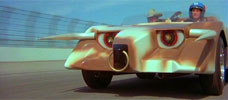
Death Race 2000
1975 -
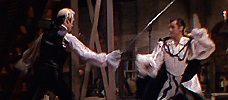
Scaramouche
1952 -

Do or Die
1991 -
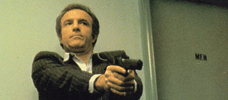
Thief
1981 -
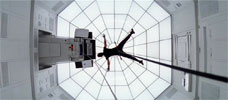
Mission: Impossible
1996 -

Invasion U.S.A.
1985 -

Rambo: First Blood Part II
1985 -

Bullitt
1968 -

Hard Hunted
1992 -

The Fugitive
1993 -

Kindergarten Cop
1990 -
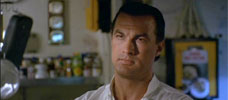
Under Siege
1992 -
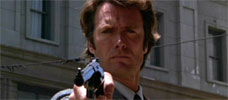
Dirty Harry
1971 -
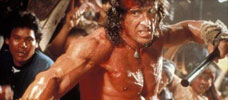
Rambo III
1988 -
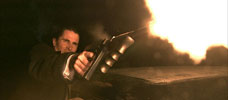
Public Enemies
2009 -

Day of the Warrior
1996 -

The Good, the Bad, the Weird
2008 -
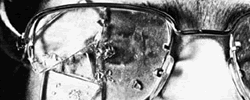
Straw Dogs
1971 -

Die Hard
1988 -

Con Air
1997 -

Collateral Damage
2002 -
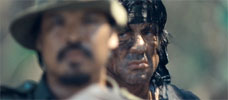
Rambo
2008
We don’t do comments anymore, but you may contact us here or find us on Twitter or Facebook.



